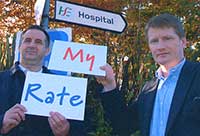Operation health inspection |
 |
| John Gibbons explains why the market was crying out for proper monitoring of our hospitals |
Ireland’s health system is rarely out of the headlines for long. The recent death of 41-year-old Susie Long, whose cancer went undiagnosed and untreated for months simply because she was a medical card patient, shocked many people.
What makes Susie different to countless other similar cases is that she broke the cardinal rule for medical card patients – that they ‘should be not seen and not heard’ – she did this by telling her story to Joe Duffy and his Liveline listeners.
She could have taken her complaint direct to the Health Service Executive (HSE) or the health minister, Mary Harney TD, but hands up who thinks that would have gotten a mere public ward patient without any ‘pull’ anywhere?
The health system, which literally holds the power of life and death over us, continues to operate as if in a bygone age, with much decision-making taking place behind closed doors and little genuine public oversight on how this behemoth operates.
Up until 2005, the now defunct health boards did at least conduct their business in public and the press was free to cover monthly meetings. Since the HSE was set up, the service has taken a big step backwards. HSE board meetings are now held in private, with no meaningful minutes or reports published.
Even the information that its chief executive, Professor Brendan Drumm, former professor of paediatrics at UCD, received an €80,000 ‘performance’ bonus had to be dragged kicking and screaming from the HSE. Maybe the fact that this bonus coincided with a ‘freeze’ in HSE spending explains their reticence.
This secrecy may seem trivial, but it is symptomatic of a sick system. When the health boards were merged into one body, the HSE, this clearly meant that lots of jobs would no longer be needed. For instance, each health board had finance and HR departments, which would all be centralised into one large executive.
So what happened to all the ‘redundant’ senior officials? It seems virtually nobody left and since public servants cannot be made redundant, we are pretty much stuck with them – regardless if there is any work for them to actually do.
This culture may go some way towards understanding the shock waves that passed through the HSE and hospitals in September last year with the launch of a ‘Rate My Hospital’ website. The 110,000 staff and management who work in the public health system are well used to having their interests represented by powerful unions.
But what about Joe and Susie Public, the hundreds of thousands of us who actually attend a hospital each year, either as patients or as relatives of those being treated. Who exactly represents us and where do we go when things go wrong?
This is where ‘Rate My Hospital’ comes in. The online service, operated by irishhealth.com, Ireland’s largest health website, has undoubtedly been useful in lifting the veil of secrecy on the country’s hospital system.
In the process, it has put a lot of new information into the public domain. For example, which Irish hospitals have good hygiene standards? What about the quality of food? Are people facing inordinate delays in being admitted for procedures?
Do patients feel there are adequate staff to look after their needs? Do they feel the hospital is well run and organised? What about patients’ experience of the quality of care and kindness they receive from hospital staff. These are all simple questions, but the answers were not in the public domain before October last year.
Of even more interest is the reaction it has provoked from official channels. Within three months of the ‘Rate My Hospital’ service being launched, the HSE had rushed out its response, with the appointment last January of a new head of consumer affairs and plans to train hundreds of hospital complaints officers.
Before , the patient had no real voice and little meaningful recourse in the event of a complaint. The knee-jerk response of the health authorities to ‘Rate My Hospital’ has been to dismiss it out of hand as just the opinions of a few online cranks.
In its first year, well over 9,000 individuals have completed the comprehensive 23-part online questionnaire, as well as around 5,000 detailed comments. (All submissions are moderated to block malicious or slanderous postings).
The UN’s World Summit Award reviewed 24,000 projects in 168 countries before selecting 40 winners, five in e-health, including ‘Rate My Hospital’. It is a boost to irishhealth.com, now seven years old and with 114,000 registered members.
More importantly, it is a serious setback for those who believe that the Irish public should be kept in the dark about our health system and who prefer to operate behind closed doors and free from annoying public scrutiny and accountability.
 |
HOSPITAL MONITORS
|
John Gibbons (john.gibbons@medmedia.ie) is director of MedMedia and publisher of Irishhealth.com









